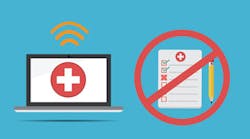Still don't have electronic health records (EHRs) for your dental practice?
Are electronic health records (EHRs) mandatory for dental practices?
Many have asked: Is the transition to EHRs federally mandatory for dental practices, and if not, when will it be? According to the American Dental Association (ADA), for the majority of dental practices, there is currently no deadline to switch to EHRs. However, this year, Medicare-eligible dentists who have not successfully switched over to EHRs and demonstrated meaningful use will be subject to a payment adjustment. The payment reduction starts at 1% and increases each year that a Medicare-eligible professional does not demonstrate meaningful use, up to a maximum of 5%. Dentists are encouraged to check with their State Medicaid Agency for applicable state law requirements.
Minnesota was the first state to add dentists, oral surgeons, and orthodontists to their EHR requirement in 2015. What impact the mandate will have has yet to be determined, as the law did not include fines or any other enforcement. However, as the health care industry is steadily moving ahead with EHR adoption, many believe other states will follow Minnesota’s lead.
Why have EHR adoption rates been so low in the dental industry?
As of 2014, 83% of office-based physicians and 97% of hospitals had adopted EHRs. While this number may seem encouraging for health care, there is a large gap when it comes to the dental industry. Many believe this is because the meaningful use incentive programs aimed at increasing adoption were not very favorable to dentists from the beginning.
Dentists are eligible to qualify for the meaningful use incentive program, but few have participated due to how difficult it is to qualify. Data from CMS indicates that as of October 2013, there were 286,771 total registrants for the meaningful use incentive program; dentists accounted for 346 of that total, and 194 dentists had received incentive payments.
Challenges and barriers of EHR adoption for dental providers
EHR adoption among dentists has been limited mostly to large dental practices; however, the majority of dental providers are small independent practices. There have been many challenges and barriers facing the adoption of EHRs for these dental practices:
• There are very few options available for certified dental EHRs that offer modules and applications appropriate for dentists, such as diagnostic, therapeutic, or decision support applications that provide the ability to capture, store, display, and analyze digital images.
• Cost to implement EHRs—Some studies estimate the cost of purchasing and installing EHRs ranges from $15,000 to $70,000 per provider.
• Lack of proven interoperability between medical and dental EHRs.
• Lack of financial incentive to invest in EHR technology. Meaningful use incentives have not been favorable for dentists.
• Lack of training on oral health IT in pre-doctoral and residency programs.
You might also want to read:
Have no fear, it is not too late! What dentists should know about EHR certification
Five steps for a successful, pain-free switch to electronic health records
Three simple steps propel you to the multiple uses of EHRs
Benefits of EHR adoption and implementation
The ADA is involved in the improvement of EHRs for the dental industry. While there are still many barriers and challenges to implementing EHRs that continue to exist for dental health providers, there are also a host of benefits.
• Improved quality and patient safety—EHRs improve the quality of documentation with built-in protocols and reminders that increase patient safety and quality of care. In fact, some malpractice insurers have started to reduce premiums for malpractice based on the practice’s use of EHRs.
• Reduced paperwork and storage issues—EHRs reduce the labor involved with managing paper charts and reduce the expenditures required to support a paper-based system. In addition, EHRs offer the potential of gaining additional office space that was once used for filing charts.
• Increased efficiency and productivity—EHRs make signing of charts more efficient by allowing them to be signed from your workstation, office, or home.
• E-prescribing—EHRs provide a convenience to patients and minimize common inefficiencies experienced between office and pharmacy.
• More efficient patient billing and improved reimbursement—EHRs decrease coding errors by using built-in alerts and required fields, which help eliminate human error and improve turnaround time for reimbursement. In addition, EHRs can help provide cost savings in paper, toner, and labor, which leads to a better bottom line.
• Increased accuracy—EHRs help standardize chart quality by minimizing problems that result from poor handwriting or inconsistencies in documentation.
As the US health care system continues to transition into the digital age, it is apparent that EHRs are here to stay. With the dental industry being an important segment of the health care system, dental providers cannot simply ignore EHRs. EHRs have the ability to improve efficiency, increase revenue by improving scheduling and billing functions, lower costs, and enhance quality of services. Whether the dental industry’s transition is eventually mandated through federal regulations or is made due to the benefits of improved patient care, many experts believe it is no longer a matter of whether the transition will take place within the dental industry, but when.
Christine Queally Foisey is president and CEO of MedSafe, where she's been since 1991 in a variety of leadership roles. Prior to MedSafe, she worked in administration and operations for ISO America and Air Machine Corporation. Christine has a strong background in cost analysis and management, strategic planning, collections, and team building for health-care organizations and is well versed in HIPAA, ICD-10, OSHA, coding, and billing compliance.






